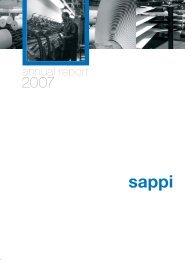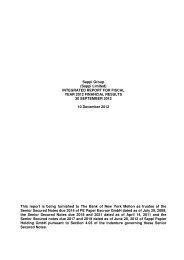SAPPI LTD (SAP) 6-K
SAPPI LTD (SAP) 6-K
SAPPI LTD (SAP) 6-K
You also want an ePaper? Increase the reach of your titles
YUMPU automatically turns print PDFs into web optimized ePapers that Google loves.
The translation of foreign currency transactions into the functional currency (functional currency concept) of an entity is as follows: The functional currency<br />
of each entity in the Company is the currency of the primary economic environment in which the entity operates. Transactions that are conducted in currencies<br />
other than the functional currency are recorded using the current exchange rate on the date of the transaction. Foreign currency denominated monetary items<br />
(e.g., cash and cash equivalents, receivables and payables) are translated at the respective closing rates. Exchange differences from the translation of monetary<br />
items are recognised in the combined income statement. Non-monetary items denominated in foreign currencies are carried at historical cost translated at the<br />
date of transaction.<br />
Foreign currency transactions are translated into the functional currency using the exchange rates prevailing at the dates of the transactions. Foreign exchange<br />
gains and losses resulting from the settlement of such transactions and from the translation at year-end exchange rates of monetary assets and liabilities<br />
denominated in foreign currencies are recognised in the income statement.<br />
Financial assets<br />
All financial assets have been classified as loans and receivables. Categorisation depends on the purpose for which the assets were acquired and is made at the<br />
time they were originally recorded. Financial asset purchases and sales are recorded at the settlement date. Loans and receivables comprise external and<br />
related party receivables, including accounts receivable. Loans and other receivables are carried at amortised cost using the effective interest method.<br />
Accounts receivable<br />
Accounts receivable are measured at the expected net realizable value, which is the original invoicing value less estimated impairment provisions on the<br />
receivables. An impairment test is carried out for all receivables at bankruptcy or overdue over 180 days, when there is a justifiable reason to assume that the<br />
Company will not receive payment from the invoiced amount according to the original terms.<br />
Cash and cash equivalents comprise cash in hand, deposits held at call with banks and other short-term highly liquid investments. Metsä Finance operates cash<br />
pooling arrangement whereby each of the Company entities participate. Cash generated and used in operations of the respective entities is regularly funded<br />
by the arrangement. Interest receivable on deposits by the Company entities is settled through the cash pooling arrangement as is interest payable on related<br />
party interest bearing liabilities. Since these funds are readily convertible to cash and are used to finance working capital of the business, management have<br />
presented such amounts due from the cash pooling arrangement as cash and cash equivalents in the combined financial statements. Cash and cash equivalents<br />
includes items with original maturities of three months or less.<br />
Financial liabilities<br />
Financial liabilities are initially recognised at fair value. Transaction costs are included in the original carrying amount of all financial liabilities.<br />
Subsequently, all financial liabilities are measured at amortised cost using the effective interest method.<br />
Inventories<br />
Inventories are measured at the lower of cost and net realizable value. The cost of finished and semi-finished products comprises raw materials, direct labour<br />
expenses, other direct expenses as well as an appropriate share of fixed and variable production overheads. The normal capacity of the production facilities is<br />
used as the divisor in allocating overheads to the different production units.<br />
The value of inventories is determined using the FIFO (first-in, first-out) method or the weighted average cost method depending on the type of inventory. Net<br />
realizable value is the estimated selling price in the ordinary course of business, less the estimated costs of completion and selling expenses. Provisions are<br />
established for slow moving and obsolete inventories.<br />
67
















